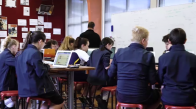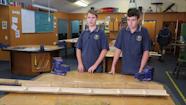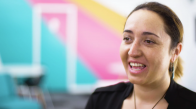Julie McMahon and Mark Greenfield discuss the application of electronics and the internet of things at St Hilda’s Collegiate and King's High School.
Learning with the internet of things in years 9–10
Transcript
Julie McMahon: When I first was introduced to this a few years ago, or a year and a half ago. I really, I think that was an area where I felt a lack of confidence and I would have said electronics isn’t my thing and I don’t know if even girls would enjoy doing this. Once I saw it, I saw how powerful it was and I really wanted to bring this into all areas, so this has been sort of my passion over the last year is to upskill myself on it and now I’m bringing it into things like etextiles.
So we’re controlling doing wearable technology, using similar technology, LED circuits, the students are programming them. We also have a project with DVC, so students have designed a whole subdivision and now they’re putting lighting into that subdivision and then they’re going to use the PICAXE boards to control the street lights, so when the light gets dim, then the streetlights will come on in the subdivision.
Another project that we’re doing cross curricular with science, is the students are redesigning our front entry to put in native plants, and then we’re going to develop an automated watering system so that we’re not wasting water, so we have a real environmental focus around it as well. It’s just powerful in the fact that it can spread to so many areas, and I think that this is my new area of passion.
Mark Greenfield: For us, the pilot project was the link to show what had been happening in the intermediate schools that contribute here to Kings, and so we were trying to find ways where we could extend the work that they had been doing within the digital technology framework that we have here. Because we needed more time, what we decided was actually a cross curricular model would work best for us, so we formed a relationship with the maths and science departments and said, “Hey look, we’ve got a tool here, can you think of how this tool could be useful for you?”. The science department came back and said, “Well we’re doing a whole lot of field testing investigations at the moment and your tool could work really well for extending the experiments that we do beyond an hour that we have for class, and actually they can do long term, three day investigations but it’s still going to take readings not only through the day but overnight”.
So the boys had to then come up with the investigation they were going to look at so they focused around which is my warmest class, which is my coldest class, or you know, which is the nice and bright sunny room or which is the really dark room, and then they developed their experiment from there. When they arrived for digital technologies, it was about what do I need the PICAXE to do? The PICAXE, is it going to be a light sensor, or is it going to be a temperature sensor? And then it’s about how regularly do I want to take readings? So we were focused on how you are nesting loops and things like that about, I want it to take a reading every 20 minutes but I still want to know if it’s going so a nice visual, flashing light to let me know that it’s working every minute, but then taking a reading every 20 was the kind of scenarios that they were developing.
When the pilot project started with the idea around looking at the water levels here in Southland and we lost a couple of classrooms when they flooded in 2015 and so it kind of resonated with us a little around actually, it would be quite interesting to see just how noticeable things like tidal pattern is, because we are on reclaimed land. We always get the anecdotes from the groundsmen and stuff who can tell you when it’s high tide because the fields are a little bit wetter than normal so we thought well, let’s see if it’s true so we actually got the kids to develop the PICAXE to actually record moisture levels.
Student 1: Basically it kind of conjoined with science and it was a really good experience. It was quite surprising that we got an entire day off to do this, so we were all quite excited. We got in there kind of having set up our devices and then each period over time, we’d have these wee sections where we set up our PICAXE devices, so it was actually really quite interesting to see how these really tiny things could just do all these things.
We started off just with the basic stuff like, we had wee lights and stuff coming off the thing, and it was all building up to when we were going to put it in our back gardens. What we did was, we got into groups of four relatively different areas between our mates, And then it was quite interesting to see, we kind of mushed them all together into this graph (which did take a while) and we had to figure it out and stuff so that took a couple of periods. Then it was great to see how the southern end was kind of slightly ahead and also the different times that it actually worked for, because obviously some people took it out longer and all these different variables came into play for the end result.
Mark Greenfield: You’re actually able to work with technology that doesn’t cost the huge amounts that currently it does if you want to buy a factory, one that comes from retail. Whereas actually being able to take things apart, no I don’t like that, and changing and being able to swap in and out was actually showing the power of the technology. The biggest battle for us now is actually knowing what’s out there and seeing what we can access so we keep accessing the resources like Andrew and sort of see what they’re looking at and see what we can bring into here at Kings.
Related videos
Learning with the internet of things: Overview of the programme (05:11)
Julie McMahon and Andrew Hornblow discuss the project, its drivers, and how simple and inexpensive electronics can be.
Senior students select their own issues
Year 12 students talk about the issues that they have selected for their projects.
Collaboration between Ngāti Rangi Trust and Ruapehu College in digital technologies (04:10)
Erena Mikaere-Most from Ngāti Rangi Trust and Principal Kim Basse discuss their collaboration and the impetus for this project....



